Assets

Dell EMC PowerFlex and VMware Cloud Foundation for High Performance Applications
Tue, 04 Jul 2023 09:44:35 -0000
|Read Time: 0 minutes
The world in 2020 has shown all industries that innovation is necessary to thrive in all conditions. VMware Cloud Foundation (VCF) hybrid cloud platform was crafted by innovators who realize the biggest asset our customers have is their information technology and the data that runs the business. The VCF offering takes the complexity out of operationalizing infrastructure to enable greater elasticity, growth, and simplification through improved automation. VCF enables options available using on-premises and multi-cloud deployments to address ever changing enterprise needs.
VMware included design factors that anticipated customers’ use of varying storage options in the flexibility of implementing VCF. VMware vSAN is the standard for VCF hyperconverged infrastructure (HCI) deployments and is directly integrated into vSphere and VCF. For those circumstances where workloads or customer resource usage require alternative storage methods, VMware built flexibility into the VCF storage offering. Just as we see a wide variety in desktop computing devices, one size doesn't fit all applies to the enterprise storage products as well. Dell Technologies’ PowerFlex (formerly VxFlex) provides a software-defined mechanism to add a combination of compute and storage with scale out flexibility. As customers look to software-defined operational constructs for agility, PowerFlex provides an adjustable means to add the right balance of storage resources while enabling non-disruptive additions without painful migrations as demands increase.
Joining the Dell Technologies Cloud family as a validated design, Dell EMC PowerFlex helps customers simplify their path to hybrid cloud by combining the power of Dell EMC infrastructure with VMware Cloud Foundation software as supplemental storage. As a high-performance, scale out, software-defined block storage product, PowerFlex provides a combination of storage and compute in a unified fabric that's well equipped to service particularly challenging workloads. The scalability of compute and/or storage in a modular architecture provides an asymmetrical (2-layer) option to add capacity to either compute or storage independently. PowerFlex makes it possible to transform from a traditional three-tier architecture to a modern data center without any trade-offs between performance, resilience or future expansion.
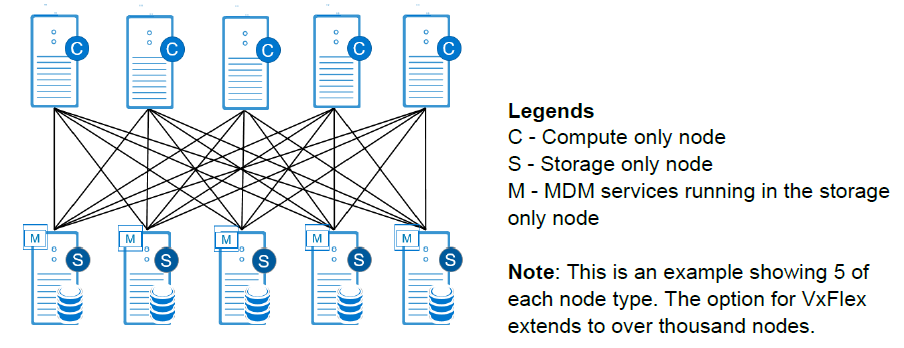
PowerFlex significantly reduces operational and infrastructure complexity, empowering organizations to move faster by delivering flexibility, elasticity, and simplicity with predictable performance and resiliency at scale for deployments. PowerFlex Manager is a key element of our engineered systems providing a full lifecycle administration experience for PowerFlex from day 0 through expansions and upgrades which is independent, but complementary to the full stack life cycle management available through VCF via SDDC Manager. A cornerstone value proposition of VCF is administering the lifecycle management of OS upgrades, vSphere updates, vRealize monitoring, automation and NSX administration. PowerFlex manager works in parallel with VCF to deliver a comprehensive lifecycle experience for the physical ingredients and for the PowerFlex software-define storage layer. PowerFlex also offers a vRealize Operations plug-in for a unified monitoring capability from VMware vRealize Suite which is included in most VCF editions. From a storage management perspective, PowerFlex utilizes a management system that complements VCF and VMware vSphere by working within the appropriate vCenter management constructs. PowerFlex Manager provides the administration of PowerFlex storage functions, while VCF and vCenter manages the allocation of LUNs to provisioned VMFS file systems to provide data stores for the provisioned workloads.
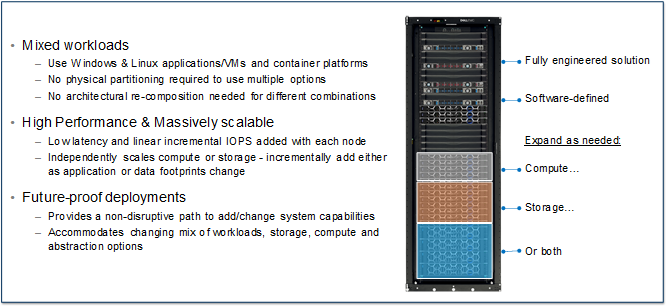
PowerFlex systems enables customers to scale from a small environment to enterprise scale with over a thousand nodes. In addition, it provides enterprise grade data protection, multi-tenant capabilities, and add-on enterprise features such as QoS, thin provisioning, compression and snapshots. PowerFlex systems deliver the performance and time-to-value required to meet the demands of the modern enterprise data center.
Does Supplemental Storage Mean Slow or Light Workload Use Cases?
PowerFlex provides a Dell Technologies validated design as a supplemental storage platform for VCF, unlocking the value of PowerFlex to be realized by customers within the VCF environment. By providing sub-millisecond latency, high IOPS and high throughput with linearity as nodes join the fabric, the result is a very predictable scaling profile that accelerates the VCF vision within the datacenter.
PowerFlex, as a part of VCF, can help solve for even the most demanding of applications. Using the supplemental capabilities to service workloads with the highest of efficiency provides a best of class performance experience. Some illustrative examples of demanding application workloads validated with PowerFlex, independent of VCF, include the following:
SAP HANA
SAP HANA certified for PowerFlex integrated rack in both 4-socket and 2-socket offerings (certification details). Highly efficient in hosting up to six production HANA instances per 4-socket server. Our capabilities outperform external competitors by hosting 2x the capacity. The Configuration and Deployment Best Practices for SAP HANA white paper provides details. While this white paper illustrates a single layer architecture, even better performance characteristics are achievable using the VCF aligned 2-layer architectural implementation of PowerFlex.
Oracle RAC & Microsoft SQL
Flexibility to run compute and storage on separate hardware results in significant reduction of database licensing cost.
- Oracle RAC Solution – Get over 1 Million IOPs with less than 1ms latency with Oracle 12c RAC database transactions in just six nodes delivering 33GB/sec throughput (5.6GB/sec per node).
- Oracle 19c RAC TPC-C achieving more than 10 Million TPMs in eight nodes.
- MS SQL 2019 Solution (white paper) or MS SQL 2019 Big Data Cluster with Kubernetes (white paper) delivering approximately 9 Million SQL Server transactions (TPMs) with less than 1ms latency using just five storage nodes.
SAS Analytics
Validated/certified by SAS for running SAS mixed analytics workloads (white paper) providing an average throughput of 210 MBs per core (40% greater than their recommended 150 MB/sec needed for certification).
Elastic Stack
The validated solution with Elastic provides customers with the required high-performance, scalable, block-based IO with flexible deployment options in multiple operating environments (Windows, Linux, Virtualized/Bare Metal). Elastic validated the efficiency of PowerFlex using only three compute and 4 storage nodes to deliver ~1 billion indexing events measured by Elastic’s Rally benchmarking tool.
EPIC
The validated PowerFlex solution for Epic delivers 6x9’s availability and high performance for critical the EPIC hyperspace workloads while simultaneously enabling hosting the VDI with the operational and analytical databases for a completely integrated infrastructure option.
Cassandra
For customers deploying Kubernetes container-based database deployments like Cassandra, PowerFlex provides 300,000 operations/second for 10 million operations (Read intensive operations) with avg read latency of 1ms on just eight nodes.
PowerFlex gives Dell Technologies the ability to help customers address diverse infrastructure needs. The implementation guide for using PowerFlex for supplemental storage provides the simple steps to provide complementary storage options for VCF deployments. For more information on the PowerFlex product family and workload solutions, please see the product page here.
Other pre-tested Dell Technologies Storage products validated for VMware Cloud Foundation that provide the capabilities to independently scale storage and compute include the offerings below. You can find more details in the Dell Technologies Cloud Validated Designs document.
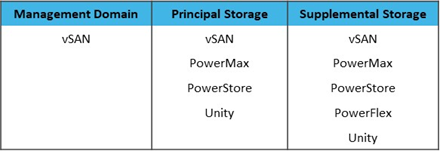

Grace Under Pressure — PowerFlex Rebuild Superpowers
Wed, 27 Jan 2021 12:30:14 -0000
|Read Time: 0 minutes
The first blog in this series, “Resiliency Explained — Understanding PowerFlex's Self-Healing, Self-Balancing Architecture,” covered an overview of how the PowerFlex system architecture provides superior performance and reliability. Today, we’ll take you through another level of detail with specific examples of recoverability.
Warning: Information covered in this blog may leave you wanting for similar results from other vendors.
PowerFlex possess some incredible superpowers that deliver performance results that run some of the world’s most demanding applications. But what happens when you experience an unexpected failure like losing a drive, a node, or even a rack of servers? Even planned outages for maintenance can result in vulnerabilities or degraded performance levels, IF you use conventional data protection architectures like RAID.
Just a reminder, PowerFlex is a high-performance software defined storage system that delivers the compute and storage system in a unified fabric with the elasticity to scale either compute, storage or both to fit the workload. PowerFlex uses all-flash direct attached media located on standard x86 servers utilizing industry standard HBA adapters and 10 Gb/s or higher ethernet NICs that interconnect servers. The systems scale from 4 nodes to multi-rack 1000+ nodes while increasing capacity, linearly increasing IOPS, all while sustaining sub-millisecond latency.
Powerful Protection
PowerFlex takes care of dynamic data placement that ensures there are NO hot spots, so QoS is a fundamental design point and not an after-thought bolt-on “fix” for a poor data architecture scheme; there’s no data locality needed. PowerFlex handles the location of data to ensure there are no single points of failure, and it dynamically re-distributes blocks of data if you lose a drive, add a node, take a node off line, or have a server outage (planned or unplanned) containing a large number of drives. It automatically load balances the placement of data as storage use changes over time or with node expansion.
The patented software architecture underlying PowerFlex doesn’t use a conventional RAID protection mechanism. RAID serves a purpose, and even options like erasure coding have their place in data protection. What’s missing in these options? Let’s use a couple of analogies to compare traditional RAID and PowerFlex protection mechanisms:
RAID
Think of RAID as a multi-cup layout where you’re looking to ensure each write places data in multiple cups. If you lose a cup, you don’t necessarily re-arrange the data. You’re protected from data loss, but without the re-distribution, you’re still operating in a deprecated state and potentially vulnerable to additional failures until the hardware replacement occurs. If you want more than one level of cup failure, you have multiple writes to get multiple cups which creates more overhead (particularly in a software-defined storage versus a hardware RAID controller-based system). It still only takes care of data protection and not necessarily performance recovery.
PowerFlex
Think of the architectural layout of data like a three-dimensional checkerboard where we ensure the data placement keeps your data safe. In the checkerboard layout, we can quickly re-arrange the checkers if you lose a box on the board or a row/column or even a complete board of checkers. Re-arranging the data to ensure there’s always two copies of the data for on-going protection and restoration of performance. The three-dimensional aspect comes from all nodes and all drives participating in the re-balancing process. The metadata management system seamlessly orchestrates re-distribution and balancing data placement.
Whether the system has a planned or unplanned outage or a node upgrade or replacement, this automatic rebalancing happens rapidly because every drive in the pool participates. The more nodes and the more drives, the faster the process of reconstituting any data rebuilding processes. In the software defined PowerFlex solution there’s no worrying about a RAID level or the performance trade-offs, it’s just taken care of for you seamlessly in the background without any of the annoying complications RAID often introduces or the need any specialized hardware controllers and associated cost.
Results
Drive Rebuild
PowerFlex looks at actual data stored on each drive rather than treating the whole drive capacity as what needs recovering. In this example, a drive failure occurs. The data levels illustrated here represent the total used capacity in these 6, 9 or 12 node configuration examples (we can scale to over 1,000 nodes). The 25%, 50% and 75% levels show relative rebuild times for this 960GB SAS SSD to return to restore the data to a full heathy state (re-protected).
We’re showing you a rebuild scenario to emphasize the performance, but taking it to another level, you wouldn’t be urgently needing to replace the drive as we leverage the data redistribution to other drives for protection and sustaining performance while using virtual spare space provided by all of the drives to pick up the gap. Unlike RAID, we don’t need to replace the drive to return the system to full health. You can replace the drive when it’s convenient.
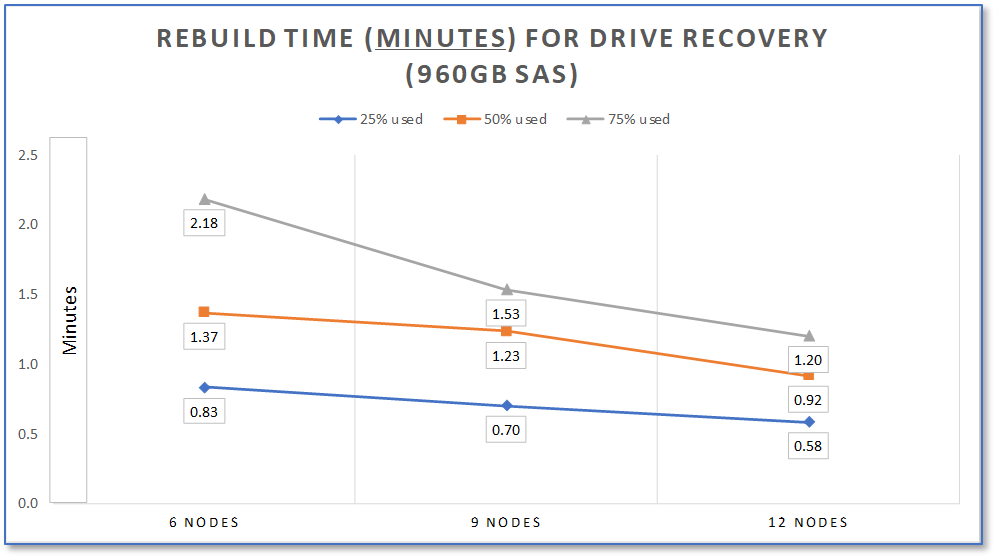
Notice a few things:
- More nodes = less rebuild time! Try this if you scale out alternative options and I think you’ll find the inverse.
- The near linear rebuild performance improves as you add more drives and nodes. Imagine if this showed even more nodes participating in the rebuild process!
- More data density doesn’t result in a linear increase in the rebuild time. As you see in the 12-node configuration, it starts to converge on a vanishing point.
This illustrates what happens when you have 35, 53, and 71 drives participating in the parallel rebuild process for the six, nine and twelve node configurations, respectively.
Node Rebuild (6 drives)
Here we show an example using a similar load level of data on the nodes. The nodes each contain six drives with a maximum of 5.76TB to be rebuilt. The entire cluster of drives participates in taking over the workloads, automatically rearranging the data placement and making sure the cluster always has two copies of the data residing on different nodes. Just as in the above drive rebuild example, the process leverages all the remaining drives from the cluster to take on the rebuild process to return to a fully protected state. That means for the six-node configuration there are 30 drives participating in the parallelized rebuild, 48 drives in the nine-node configuration and 66 drives in the twelve nodes.
Notice again the near linear improvement in rebuild times as you increase the number of nodes and drives. As in the drive rebuild scenario, the node rebuild time observed also tends to approach a vanishing point for the varying data saturation levels.
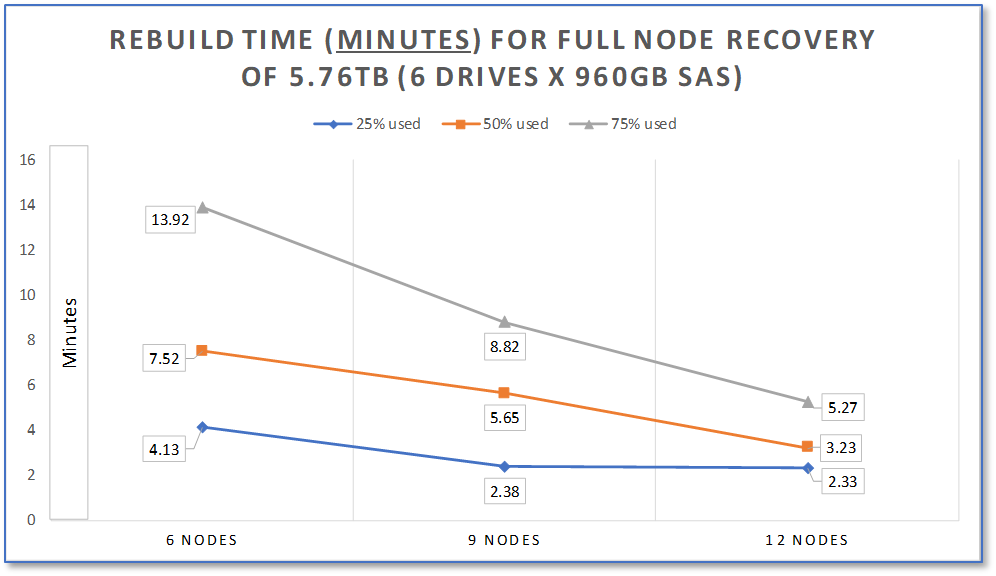
As mentioned previously, PowerFlex scales to 1000+ nodes. Take a scenario where you need to affect an entire rack of servers and remain operational and recoverable (unthinkable in conventional architectures) and you see why our largest customers depend on PowerFlex.
Testing Details
If the above tests were done just to show off the best rebuild times, we would just run these systems without any actual other work occurring. However, that wouldn’t reflect a real-world scenario where the intention is to continue operating gracefully and still recover to full operational levels.
These tests were done with the PowerFlex default rebuild setting of one concurrent I/O per drive. For customers with more aggressive needs to return to fully protected, PowerFlex can be configured to accelerate rebuilds as a priority. To optimize rebuilds even more than illustrated, you can set the number of concurrent I/Os per drive to two or more or even unlimited. Since changing the number of I/Os per drive does affect latency and IOPS, which could adversely impact workloads, we chose to illustrate our default example that intentionally balances keeping workload performance high while doing the rebuild.
Using FIO* as a storage I/O generator, we ran these rebuild scenarios with ~750k random IOPS of activity on the 12 node configuration, ~600k random IOPS on the 9-nodes and ~400k on the 6-nodes, all while sustaining 0.5mS latency levels (cluster examples here can drive well over 1M IOPS at sub-mS levels). This represents a moderately heavy workload operating while we performed these tests. Even with the I/O generator running and the rebuild process taking place, the CPU load was approximately 20%. The I/O generator alone only consumed 8 to 10% of the available CPU capacity. Both CPU utilization figures underscores the inherent software defined infrastructure efficiency of PowerFlex that leaves a lot of available capacity to host application workloads. In this test case scenario, both the compute and storage occupied the same node (hyperconverged), but remember that we can also run a in 2-layer configuration using compute only and storage only nodes for asymmetrical scaling.
The systems used for these tests had the following configuration. Note that we used six drives per node in the R740xd chassis that can hold 24 drives, which means there were another 18 slots available for additional drives. As noted previously, more drives mean more parallel capabilities for performance and rebuild velocity.
- 12x R740xd nodes with 2 sockets Intel Xeon Gold 2126 2.6Ghz (12 cores /socket)
- Six had 256GB RAM & six utilized 192GB RAM
Conclusion
PowerFlex delivers cloud scale performance with unrivaled grace under pressure reliability for delivering a software defined block storage product with six nines of availability. Be sure to read Part 1 of this blog “Resiliency Explained — Understanding PowerFlex's Self-Healing, Self-Balancing Architecture” to see the other protection architecture elements not covered here. For more information on our validated mission critical workloads like Oracle RAC, SAP HANA, MySQL, MongoDB, SAS, Elastic, VDI, Cassandra and other business differentiating applications, please visit our PowerFlex product site.
Footnotes
* FIO set for 8k, 20% random write, 80% random reads

A Case for Repatriating High-value Workloads with PowerFlex Software-Defined Storage
Tue, 20 Oct 2020 12:16:04 -0000
|Read Time: 0 minutes
Kent Stevens, Product Management, PowerFlex
Brian Dean, Senior Principal Engineer, TME, PowerFlex
Michael Richtberg, Chief Strategy Architect, PowerFlex
We observe customers repatriating key applications from the Cloud, help you think about where to run your key applications, and explain how PowerFlex’s unique architecture meets the demands of these workloads in running and transforming your business
For critical software applications you depend upon to power core business and operational processes, moving to “The Cloud” might seem the easiest way to gain the agility to transform the surrounding business processes. Yet we see many of our customers making the move back home, back “On-Prem” for these performance-sensitive critical workloads – or resisting the urge to move to The Cloud in the first place. PowerFlex is proving to deliver agility and ease of operations for the IT infrastructure for high-value, large-scale workloads and data-center consolidation, along with a predictable cost profile – as a Cloud-like environment enabling you to reach your business objectives safely within your own data center or at co-lo facilities.
IDC recently found that 80% of their customers had repatriation activities, and 50% of public-cloud based applications were targeted to move to hosted-private cloud or on-premises locations within two years(1). IDC notes that the main drivers for repatriation are security, performance, cost, and control. Findings reported by 451 Research(2) show cost and performance as the top disadvantages when comparing on-premises storage to cloud storage services. We’ve further observed that core business-critical applications are a significant part of these migration activities.
If you’ve heard the term “data gravity,” which relates to the difficulty in moving data to and from the cloud and that may only be part of the problem. “Application” gravity is likely a bigger problem for performance sensitive workloads that struggle to achieve the required business results because of scale and performance limitations of cloud storage services.
Transformation is the savior of your business – but a problem for your key business applications
Business transformation impacts the data-processing infrastructure in important ways: Applications that were stable and seldom touched are now the subject of massive changes on an ongoing basis. Revamped and intelligent business processes require new pieces of data, increasing the storage requirements and those smarts (the newly automated or augmented decision-making) require constant tuning and adjustments. This is not what you want for applications that power your most important business workflows that generate your profitability. You need maximum control and full purview over this environment to avoid unexpected disruptions. It’s a well-known dilemma that you must change the tires while the car is driving down the road – and today’s transformation projects can take this to the extreme.
The infrastructure used to host such high-profile applications – computing, storage and networking – must be operated at scale yet still be ready to grow and evolve. It must be resilient, remain available when hardware fails, and be able to transform without interruption to the business.
Does the public cloud deliver the results you expected?
Do your applications require certain minimum amounts of throughput? Are there latency thresholds you consider critical? Do you require large data capacities and the ability to scale as demands grow? Do require certain levels of availability? You may assume all these requirements come with a “storage” product offered by the public cloud platforms, but most fall short of meeting these needs. Some require over-provisioning to get better performance. High availability options may be lacking. The highest performing options have capacity scale limitations and can be prohibitively expensive. If you assume what you’ve been using on-prem comes from a hyperscaler, you may be quite surprised that there are substantial gaps that require expensive application rearchitecting to be “cloud native” which may become budget busters. These public cloud attributes can lead to “application gravity” gaps.
While the agility of it is tempting, the unexpected costliness of moving everything to the public cloud has turned back more than one company. When evaluating the economics and business justification for Cloud solutions, many costs associated with full-scale operations, spikes in demand or extended services can be hard to estimate, and can turn out to be large and unpredictable.
The full price of cloud adoption must account for the required levels of resiliency, management infrastructure, storage and analytics for operational data, security solutions, and scaling up the resources to realistic production levels. Recognizing all the necessary services and scale may undermine what might have initially appeared to be a solid cost justification. Once the budget is established, active effort and attention must be devoted to monitoring and oversight. Adapting to unexpected operational events, such as bursting or autoscaling for temporary spikes in workload or traffic, can bring unforeseen leaps in the monthly bill. Such situations can be especially hard to predict and plan for – and very difficult to control.
You want the speed, convenience and elasticity of running in the cloud - but how do you ensure that agility while staying within the necessary bounds of cost and oversight? Truly transformative infrastructure allows businesses to consolidate compute and storage for disparate workloads onto a single unified infrastructure to simplify their environment, increase agility, improve resiliency and lower operational costs. And your potential payoff is big with far easier scaling, more efficient hardware utilization, and less time spent figuring out how to get things right or tracking down issues that complicate disparate system architectures.
Software-Defined is the Future
IDC Predicts that by 2024, software-defined infrastructure solutions will account for 30% of storage solutions(3). At the heart of the PowerFlex family, and the enabler of its flexibility, scale and performance is PowerFlex software-defined storage. The ease and reliability of deployment and operation is provided by PowerFlex Manager, an IT operations and lifecycle management tool for full visibility and control over the PowerFlex infrastructure solutions.
PowerFlex’s unmatched combination of flexibility, elasticity, and simplicity with predictable high performance - at any scale - makes it ideally suited to be the common infrastructure for any company. Utilizing software defined storage (SDS) and hosting multiple heterogeneous computing environments, PowerFlex enables growth, consolidation, and change with cloud-like elasticity – without barriers that could impede your business.
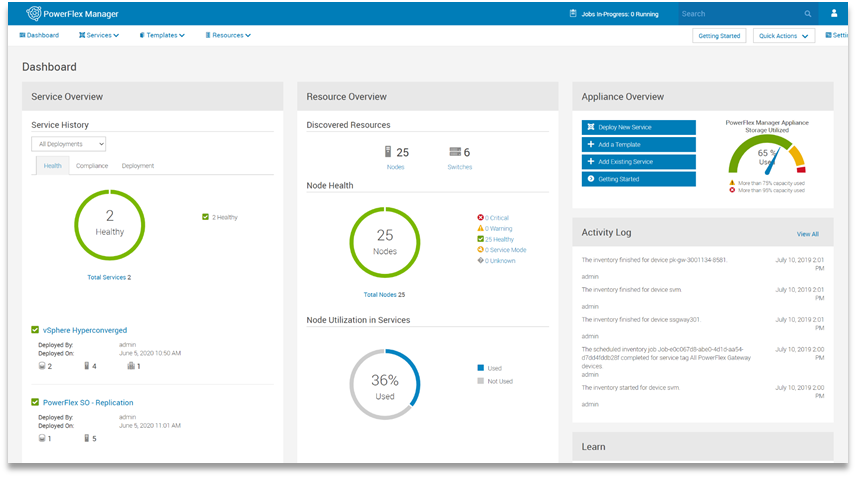
The resulting unique architecture of the PowerFlex family easily meets the large-scale, always-on requirements of our customers’ core enterprise applications. The power and resiliency of the PowerFlex infrastructure platforms handle everything from high-performance enterprise databases, to web-scale transaction processing, to demanding business solutions in various industries including healthcare, utilities and energy. And this includes the new big-data and analytical workloads that are quickly augmenting the core applications as the business processes are being transformed.
PowerFlex: A Unique Platform for Operating and Transforming Critical Applications
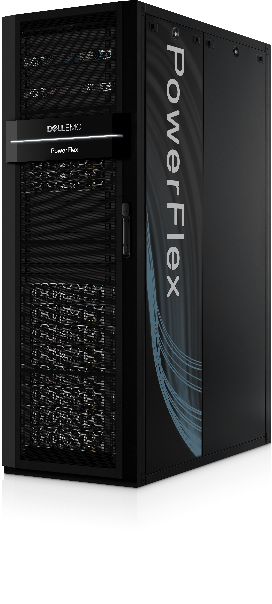 PowerFlex provides the flexibility to utilize your choice of tools and solutions to drive your transformation and consolidation, while controlling the costs of the relentless expansion in data processing. PowerFlex provides the modularity to adapt and grow efficiently while providing the manageability to simplify your operations and reduce costs. It provides the scalable infrastructure on-premises to allow you focus on your business operations. PowerFlex on-demand options by the end of 2020 enable an elastic OPEX consumption model as well.
PowerFlex provides the flexibility to utilize your choice of tools and solutions to drive your transformation and consolidation, while controlling the costs of the relentless expansion in data processing. PowerFlex provides the modularity to adapt and grow efficiently while providing the manageability to simplify your operations and reduce costs. It provides the scalable infrastructure on-premises to allow you focus on your business operations. PowerFlex on-demand options by the end of 2020 enable an elastic OPEX consumption model as well.
As your business needs change, PowerFlex provides a non-disruptive path of adaptability. As you need more compute, storage or application workloads, PowerFlex modularly expands without complex data migration services. As your application infrastructure needs change from virtualization to containers and bare metal, PowerFlex can mix and match these in any combination necessary without needing physical changes or cluster segmentation. PowerFlex provides future-proof capabilities that keep up with your demands with six nines of availability and linear scalability.
With the dynamic new pace of growth and change, PowerFlex can ensure you stay in charge while enabling the agility to adapt efficiently. PowerFlex enables you to leverage the advantages of oversight and cost-effectiveness of the on-premises environment with the ability to meet transformation head-on.
For more information, see PowerFlex on Dell EMC.com, or reach out to Contact Us.
footnotes:
1 IDC Cloud Repatriation Accelerates in a Multi-Cloud World, July 2018
2 451 Research, 2020 Voice of the Enterprise
3 IDC FutureScape: Worldwide Enterprise Infrastructure 2020 Predictions, October 2019

